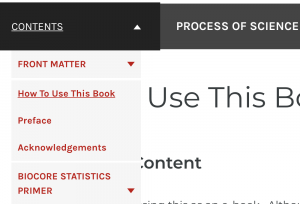How To Use This Guide
Quick Links
Overview
The English 100 Instructors’ Guide (IG) collects information and guidance for instructors. As a member of our instructional staff, you have flexibility in developing your own section of the course, but we require key elements in all classes to encourage coherence throughout the program. You’ll find these in the section on Required Curriculum Elements.
This book outlines the beliefs, values, and recommendations of our program, compiled by multiple experienced instructors through many years. This is a living document, meaning that each year the content changes, grows, and adapts in response to the institutional climate and disciplinary best practices (please see the Revisions and Updates page for an archive of recent changes to the IG). As such, this Guide is meant to be used for both training and reference; it is an introduction to our program for new instructors and a reminder/reference for experienced instructors.
While we might make adjustments to curriculum and recommendations, what will remain consistent are our program’s core beliefs and values that recognize students as already experienced writers and users of language. The work of our classes builds on students’ varied experiences, offering sustained practice in the writing process and engaging a range of literacies that include reading, information gathering, speaking, and listening. We ask all instructors to read through the IG with care and use it to guide choices in crafting a course grounded in these beliefs and values.
Using the Guide as a Reference
All of the information within this book is relevant to your teaching of E100, so we ask all new instructors to read through the book in its entirety, beginning to end. However, after that initial reading, this book can be used as a reference in a variety of ways. So, here are suggestions for how to use this book:
New Instructors
We recommend all new instructors start with the course learning goals and outcomes, as the General Education requirements at UW-Madison differ from many other institutions. Then, look over the section titled Your Job as an English 100 Instructor, starting with the Instructors’ Responsibilities to Students chapter. New TAs will want to take special note of the TA Workload and the Essential Duties of English 100 Instructors sections.
Then, you may want to dive into the course content, including the description of the curriculum, the model syllabus and calendar, and teaching notes for recommended readings. We provide sample assignments for each of the three sequences here, and more are located on Canvas. The model syllabus and calendar will show you more about the recommended pace and structure of the course. We also encourage multimodal projects.
Finally, you may want to spend time looking over the grading and assessment sections, particularly if you are less familiar with portfolio assessment, and the Designing and Planning sections as you begin to think about the shape of your course.
Experienced Instructors
Experienced instructors will want to explore the sections added or significantly revised for the 2023-2024 Instructor’s Guide, which include the following:
- Responsibilities of the Program
- Supporting Student and Instructor Wellness
- Assessment of Engagement and Information about the UW-Madison Grading Scale
- AI Writing
- Expanded Resources (especially campus and local resources)
We will be adding information about a new reporting process for struggling students closer to the start of the school year. Please keep an eye on the Revisions and Updates page for ongoing changes to the IG throughout the year.
Supporting Struggling Students
Instructors looking for resources to support struggling students can find suggestions for student assistance in the Wellness chapter, the Resources appendix, and the updated reporting process for struggling students (coming soon). You are also welcome to reach out to the admin team for additional support.
Other Writing Program Constituents
Others interested in learning more about our program should take special note of our program values and learning outcomes, the required curriculum elements, and the sample syllabus, calendar, and assignments, as these reveal our program values in practice.
Navigation
In the IG, we provide both recommendations and requirements for how those beliefs and values are enacted in E100 pedagogical practice and assessment. This guide includes links to a model syllabus and daily sample calendars for both MWF and two-day course schedules. The calendar covers all three sequences and suggests possible weekly and daily goals as well as activities, readings, and lesson plans. This guide also provides sample assignments for each sequence, as well as information about developing multimodal projects. English 100 uses a portfolio system for grading and stresses the use of low-stakes, scaffolded assignments to build toward portfolios. Only portfolios receive grades, but assessment is ongoing, with feedback provided through peer-review, conferencing, and instructor comments.
Navigating the Pressbook
The sidebar menu at the top of the webpage for each chapter follows the same logic. In the web version of this text, you will see a Contents drop-down menu anchored in place at the top-left of each chapter. Clicking on the small arrow icon will unfurl a table of contents. From there, you can click on a chapter or section to navigate within the text.

Next and Previous Chapter Buttons
Each page in the text also features a “previous” and “next” button.
Depending on the size of the screen you’re using, this button will either appear in the middle-right of your page like this:
or at the bottom of your page like this:
Hyperlinks
The hyperlinks in this text appear underlined and highlighted in red. Clicking on them will take you either to a different section in this course reader or to an external webpage.

You can return to the location of the original hyperlink by clicking the back arrow.


